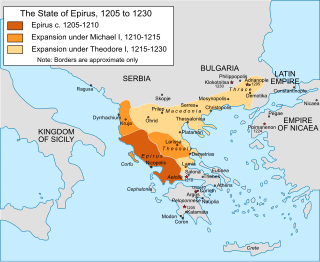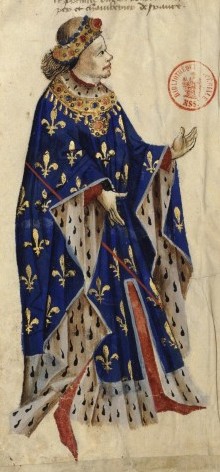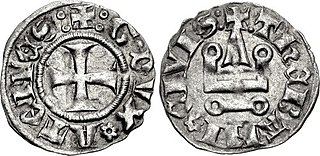
The Principality of Achaea or Principality of Morea was one of the three vassal states of the Latin Empire, which replaced the Byzantine Empire after the capture of Constantinople during the Fourth Crusade. It became a vassal of the Kingdom of Thessalonica, along with the Duchy of Athens, until Thessalonica was captured by Theodore, the despot of Epirus, in 1224. After this, Achaea became for a while the dominant power in Greece.

The Despotate of Epirus was one of the Greek successor states of the Byzantine Empire established in the aftermath of the Fourth Crusade in 1204 by a branch of the Angelos dynasty. It claimed to be the legitimate successor of the Byzantine Empire, along with the Empire of Nicaea and the Empire of Trebizond, its rulers briefly proclaiming themselves as Emperors in 1227–1242. The term "Despotate of Epirus" is, like "Byzantine Empire" itself, a modern historiographic convention and not a name in use at the time.

Louis I, called the Lame was a French prince du sang, Count of Clermont-en-Beauvaisis and La Marche and the first Duke of Bourbon, as well as briefly the titular King of Thessalonica from 1320 to 1321.

Philip I of Taranto, of the Angevin house, was titular Latin Emperor of Constantinople by right of his wife Catherine of Valois–Courtenay, Despot of Romania, King of Albania, Prince of Achaea and Taranto.

Philip II of the Angevin house, was Prince of Achaea and Taranto, and titular Latin Emperor of Constantinople from 1364 to his death in 1373.

Robert II of Taranto, of the Angevin family, Prince of Taranto (1331–1346), King of Albania (1331–1364), Prince of Achaea (1332–1346), and titular Latin Emperor.
Thamar Angelina Komnene was a princess consort of Taranto by marriage to Prince Philip I.
Nikephoros I Komnenos Doukas, Latinized as Nicephorus I Comnenus Ducas was ruler of Epirus from 1267/8 to his death in 1296/98.

Nicholas Orsini was a Greek–Italian nobleman who was count palatine of Cephalonia from 1317 to 1323 and ruler of southern Epirus around Arta from 1318 to 1323. The son of Count John I Orsini and an Epirote princess, he succeeded his father upon the latter's death, and in the next year murdered his uncle, Thomas Komnenos Doukas, and usurped his rule of Epirus. While able to secure his control over southern Epirus, however, the north with the city of Ioannina were taken over by the Byzantine Empire. Nicholas' attempts to ally with the Republic of Venice and recover Ioannina failed, and he was in turn killed by his brother John II Orsini in 1323.

Louis of Burgundy was a member of the Capetian House of Burgundy who ruled the Principality of Achaea and claimed the defunct Kingdom of Thessalonica.

Isabella of Villehardouin was reigning Princess of Achaea from 1289 to 1307. She was the elder daughter of Prince William II of Achaea and of his third wife, Anna Komnene Doukaina, the second daughter of Michael II Komnenos Doukas, the despot of Epiros.

Centurione II Zaccaria, scion of a powerful Genoese merchant family established in the Morea, was installed as Prince of Achaea by Ladislaus of Naples in 1404 and was the last ruler of the Latin Empire not under Byzantine suzerainty.

Guy II de la Roche, also known as Guyot or Guidotto, was the Duke of Athens from 1287, the last duke of his family. He succeeded as a minor on the death of his father, William I, at a time when the duchy of Athens had exceeded the Principality of Achaea in wealth, power, and importance.

Matilda of Hainaut, also known as Maud and Mahaut, was Princess of Achaea from 1316 to 1321. She was the only child of Isabella of Villehardouin and Florent of Hainaut, co-rulers of Achaea 1289–1297. After Florent's death in 1297, Isabella continued to rule alone until she remarried to Philip of Savoy in 1300. Per arrangements made with King Charles II of Naples, Isabella was not allowed to marry without his consent and after Philip failed to adequately participate in the king's campaigns against Epirus, Charles in 1307 revoked their rights to Achaea. Matilda, just fourteen years old, tried to press her claim as their heir but was refused by the bailiff Nicholas III of Saint Omer, who instead chose to wait for orders from Naples. Shortly thereafter, Charles appointed his favorite son, Philip of Taranto as the new Prince of Achaea.

The County Palatine of Cephalonia and Zakynthos existed from 1185 to 1479 as part of the Kingdom of Sicily. The title and the right to rule the Ionian islands of Cephalonia and Zakynthos was originally given to Margaritus of Brindisi for his services to William II, King of Sicily, in 1185.

The Capetian House of Anjou or House of Anjou-Sicily, was a royal house and cadet branch of the direct French House of Capet, part of the Capetian dynasty. It is one of three separate royal houses referred to as Angevin, meaning "from Anjou" in France. Founded by Charles I of Anjou, the youngest son of Louis VIII of France, the Capetian king first ruled the Kingdom of Sicily during the 13th century. Later the War of the Sicilian Vespers forced him out of the island of Sicily, leaving him with the southern half of the Italian Peninsula — the Kingdom of Naples. The house and its various branches would go on to influence much of the history of Southern and Central Europe during the Middle Ages, until becoming defunct in 1435.
Marie of Bourbon was the empress consort of Robert of Taranto, titular Latin Emperor of Constantinople. She was the sovereign baroness of Vostitsa in 1359-1370.

Richard Orsini was the count palatine of Cephalonia and Zakynthos from before 1260 to his death in 1303/4, and also Count of Gravina in 1284–91. He also served on behalf of the Angevin Kingdom of Naples as captain-general of Corfu in 1286–90 and as the bailli in the Principality of Achaea from 1297 to 1300. He assisted the Despot of Epirus in battle against the Byzantine Empire, and secured the marriage of his son, John I, to the Epirote ruler's daughter, which would lead in 1318 to the Orsini takeover of Epirus.

John I Orsini was the count palatine of Cephalonia and Zakynthos from 1303 or 1304 to his death in 1317. Married to an Epirote princess, John spent a decade at the Epirote court before succeeding his father, Richard Orsini, as count palatine. As a vassal of the Principality of Achaea, he was involved in its domestic affairs and especially the dynastic dispute between the infante Ferdinand of Majorca and Princess Matilda of Hainaut in 1315–16, and participated in a number of Latin campaigns against Epirus, which he aspired to rule. A year after his death, his son and heir Nicholas Orsini seized Epirus and brought it under the Orsini family's rule.
Charles of Taranto was the eldest son of Philip I, Prince of Taranto and titular Latin Emperor of Constantinople, and his wife, Thamar Angelina Komnene, daughter of the Despot of Epirus, Nikephoros I Komnenos Doukas.